Boite Nature Boxes
A National Cigar History Museum Exclusive
© 2019 Tony Hyman
adjusted for readility 03-18-19

Boite Nature Boxes
A National Cigar History Museum Exclusive
© 2019 Tony Hyman
adjusted for readility 03-18-19
A Boite Nature [bow-waht nah-tchoor] is a very specific type of cigar box that appeared for the first time around 1900, though the exact date the design originated is unknown.
Called “BN” or “full BN” by the box trade, the name is French for ‘natural packing.’ The term was originally applied only to boxes made entirely of cedar, based on the long-held belief in the natural affinity of cedar for fine tobacco. BN’s were made of Cuban, Honduran or Philippine mahogany, all of which bear a resemblance to cedar, and with a quick spray of cedar scent were passed off as such. Nearly all contemporary BN boxes are made of redwood.
A full BN box is entirely made of wood and has machine-cut interlocked corners. The trade calls them locked corners; boxes are said to have “lockwork.” When describing cigar boxes, it is a common error of beginners to describe lockwork as “dovetailing.” A dovetail is a hand-made furniture joint, triangular in shape which resembles the bird’s tail from which it got its name. Locks are short, precise, machine-cut, and form highly regular corners. Millions of locked boxes have been made and continue to be produced in high numbers into the 2000’s.
The bottom and corners of BN boxes are usually glued not nailed. A BN box has “full hardware,” two hinges and a clasp. Note that the hinges and clasp of a BN box do not overlap onto the top of the lid, but are entirely on the front and back of the box. Hinges and clasps were nailed to the box until the 1930’s, when machine stapling of hinges and clasps became common.
A boite nature box gives added protection to the cigars inside by means of a collar, four wooden inserts along the inside edges of the ebox which help to form an air seal when the box is closed. Sticklers for detail should note that a true BN box has no advertising labels affixed to the outside of the box. Old time industry purists object even when labels are used inside a BN box, since tradition dictates that only the brand name and a few other words POB in an oval should appear on a BN box. The words “Boite Nature” are frequently found POB on one end of the box.
Cigars of every price range have been packed in BN’s but they were used primarily for 5¢ cigars. When nickel cigars were packed in a BN box smokers took it as a symbol of elegance but makers selected BN’s for cost efficiency. BN’s were used mostly for short run house brands and it was cheaper to make the brass or zinc printing dies than to print paper labels.
Unusual BN 10/10
1st PA to hold large foiled cigars costing $1 each in 1932, during
the heart of the Great Depression. $150
BN Box Maker’s Catalog c1915
Unusual BN’s
Customizing could be as simple as pasting on a label. Personally collected by me in Brawley, CA, while summer traveling with dad in the early 1950’s.
Most common BN after 1960
BN’s greatest popularity was as “custom brands.”
Hardware used on 90% of all pre-1960 BN boxes
All dates approximate, based on boxes in the collection.
Most common BN boxes
Jose Escalante Fact. 70 New Orleans, Louisiana
This example does not have an interior price sticker, but most did. Larks cost a dime before WWII, 11¢ and 12¢ during the war, and finally 15¢ afterward. In the 1950’s, Jose Escalante was the country’s largest user of redwood BN packaging. These attractive sturdy boxes have survived in very large numbers. [8854]

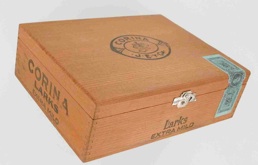
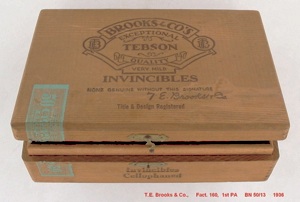





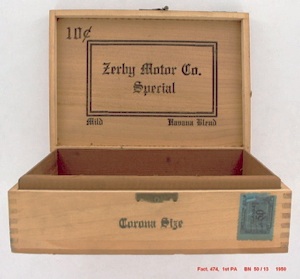

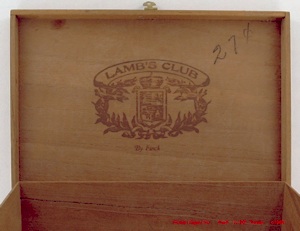
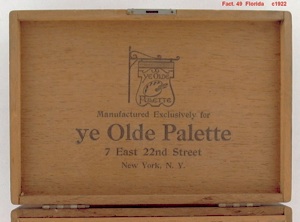

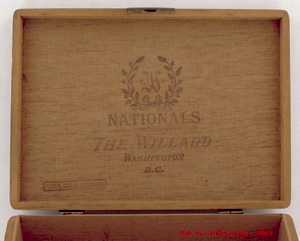
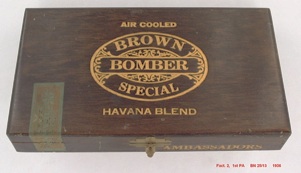



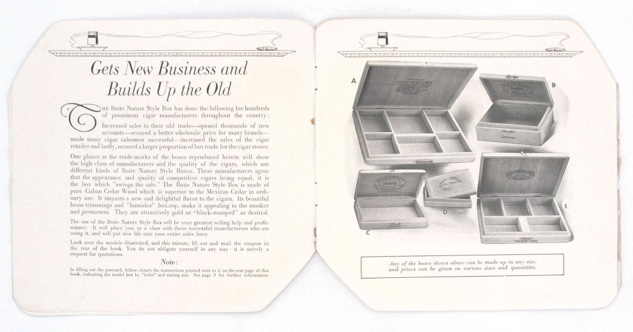
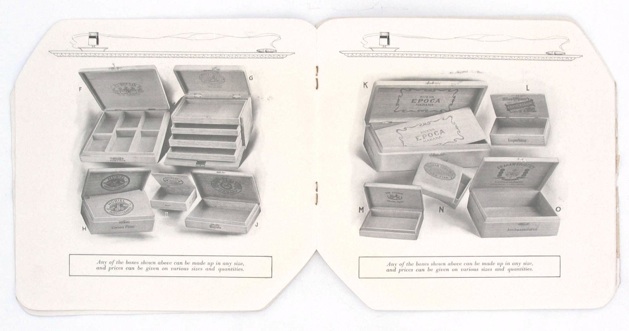


Flap - spacers
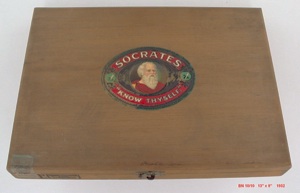






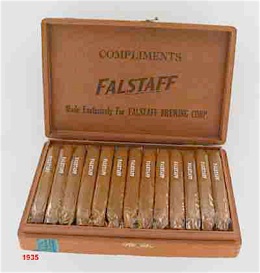
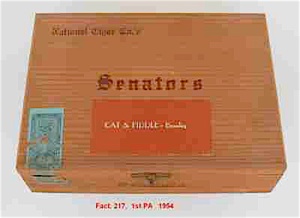
Promotional copy



[04497] $ [04498] $
[04494] $ [09814]
1900-1940 1900-1940 1910-1940 1915-1940 1930-today
Type I Type II Type III Type IV Type V
ball pivot flat pivot snap over slide machine stapled
Types I & II hinges were used in the 1800’s on other wooden boxes and continue in use until WWII. Type IV clasps were the most expensive of the four. Box makers began converting to Type V hard-ware in the 1930’s as it was easier and faster to install and much less costly. Type V hinges and clasps come in long strips and are machine stapled into a box as soon as the lid is sawn off.
if your box doesn’t have a clasp, it’s either damaged or not a full BN box.
Another of the three brands most often seen using BN boxes, BROOKS & Co’s TEBSON Invincibles. Brooks began using both BN 50/13 and BN 50/10 in the 1930’s and continued to do so for decades. They also packed in standard NW and cardboard boxes.
T.E. Brooks & Co., Fact. 160, 1st PA 1936
During the cigar industry’s modern (post 1960) era, HOUSE OF WINDSOR was the most common BN box. The groves are a design device, and make it stand out from other BN’s.
House of Windsor, TP 33 Windsor, PA 1970’s
COMPLIMENTS FALSTAFF BREWERY was made in 1935 and a classic example of a BN box used by gift-giving businesses large and small. A beer and a cigar sounds like an appealing combination. Cigars made in Factory 305 KY by the Irwin S. Cobb Cigar Co., located at 1501 South 3rd Street in Paducah. The cigar company closed not long after making these.
[09818]
ALASKA CHEMICAL COMPANY is a name that doesn’t come to mind when fine cigars are discussed. A collection of “private label” BNs would be interesting and inexpensive as BNs seldom sell for more than $10 at fleas or on eBay. All but two of the BN’s you see in this exhibit held 5¢ cigars.
$
Fact. 20 Florida c1914 [04493]
Zerby Motors may have given these to car buyers, though the price marker makes that doubtful. The Museum collection includes similar boxes for Oldsmobile and Huppmobile.
[04400]
$
BN’s were most commonly used to display “custom brand” cigars for various retailers. You’ll see them with names of hotels, bars, men’s clubs, restaurants, tobacconists, golf courses, furriers and other retailers.
[04499] $ [04495] Famous Hollywood $
The Brown Bomber was the nickname of world heavyweight boxing champ Joe Louis. The use of symbolic dark brown (Louis’s color) and gold printing are unusual characteristics for a BN box.
Fact. 2. 1st PA 1938. $
What “air cooled” means is unknown, but it sounds good. “Havana blend” does NOT mean Cuban tobacco as Havana is a type of tobacco widely grown in the Northeast and Midwest.
This box is a BN in every way except [1] the box has been covered with a black material of some sort and [2] a paper label is used as an inner. Purists might call it an SBN. Whatever you call it, it’s a very nice box with a classic 20’s label design.
Custom BN 50/13 Fact. 1646, 1st PA 1920’s
Box maker, Wm. Black & Co., was located on East 94th St. in New York City. Black & Co. specialized in making BN boxes for the candy and cigar trade. Their catalog includes boxes which purists call Semi-BN’s. Note that none are illustrated with paper labels.
According to the box maker’s catalog this is a BN box, though missing hinges and a clasp. Sounds logical to me, but the box makers I inter-viewed in the 1970’s made a big distinction between Semi-BN’s and BN’s. Technicalities!
Names and definitions change over time. Few collectors care. “SBN 10/5 sliptop” is how I would describe this in a catalog. 1920’s.
[3568] $20
BN boxes often used thin wood sheets for a floating flap and for spacers between rows within the box. They’re notched at the corner to facilitate removing them from the box. They usually get thrown away or used in a workshop, so are rarely found with their original box.
You will occasionally find BN boxes with ad copy promoting the use of all-wood boxes.